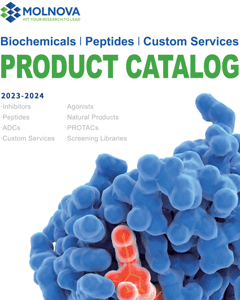
β-Amyloid 1-16
CAS No. 131580-10-4
β-Amyloid 1-16( Amyloid β-Protein (1-16) )
Catalog No. M29927 CAS No. 131580-10-4
β-Amyloid (1-16) is a β-Amyloid protein fragment involved in metal binding. Beta-amyloid is a peptide that forms amyloid plaques in the brains of Alzheimer's disease (AD) patients.
Purity : >98% (HPLC)
 COA
COA
 Datasheet
Datasheet
 HNMR
HNMR
 HPLC
HPLC
 MSDS
MSDS
 Handing Instructions
Handing Instructions
| Size | Price / USD | Stock | Quantity |
| 5MG | 267 | Get Quote |


|
| 100MG | Get Quote | Get Quote |


|
| 200MG | Get Quote | Get Quote |


|
| 500MG | Get Quote | Get Quote |


|
Biological Information
-
Product Nameβ-Amyloid 1-16
-
NoteResearch use only, not for human use.
-
Brief Descriptionβ-Amyloid (1-16) is a β-Amyloid protein fragment involved in metal binding. Beta-amyloid is a peptide that forms amyloid plaques in the brains of Alzheimer's disease (AD) patients.
-
Descriptionβ-Amyloid (1-16) is a β-Amyloid protein fragment involved in metal binding. Beta-amyloid is a peptide that forms amyloid plaques in the brains of Alzheimer's disease (AD) patients.(In Vivo):β-amyloid (1-16) fragment is considered as valid models to examine the contribution of the key histidine residues (His , His in mouse and His , His , His in human fragments) to the Ab–Cu2+ interaction. Oxidation targets for β-Amyloid (1-16) are the histidine residues coordinated to the metal ions. Copper is bound to Aβ in senile plaque of Alzheimer’s disease with β-Amyloid (1-16) taking part in the coordination of the Cu2+ ions. Cu2+ and Zn2+ are linked with the neurotoxicity of -Amyloid and free radical damage. β-amyloid (1-16) is the minimal amino acidic sequence display a Cu coordination mode which involves three Histidines (His6, His13 and His14). β-amyloid (1-16) is supposed to be involved in metal binding. Human β-amyloid interacts with zinc ions through its metal-binding domain 1-16. The C-tails of the two polypeptide chains of the rat Aβ(1-16) dimer are oriented in opposite directions to each other, which hinders the assembly of rat Aβ dimers into oligomeric aggregates. Thus, the differences in the structure of zinc-binding sites of human and rat β-Amyloid (1-16), their ability to form regular cross-monomer bonds, and the orientation of their hydrophobic C-tails could be responsible for the resistance of rats to Alzheimer's disease.
-
In Vitro——
-
In Vivoβ-amyloid (1-16) fragment is considered as valid models to examine the contribution of the key histidine residues (His , His in mouse and His , His , His in human fragments) to the Ab–Cu2+ interaction. Oxidation targets for β-Amyloid (1-16) are the histidine residues coordinated to the metal ions. Copper is bound to Aβ in senile plaque of Alzheimer’s disease with β-Amyloid (1-16) taking part in the coordination of the Cu2+ ions. Cu2+ and Zn2+ are linked with the neurotoxicity of -Amyloid and free radical damage. β-amyloid (1-16) is the minimal amino acidic sequence display a Cu coordination mode which involves three Histidines (His6, His13 and His14). β-amyloid (1-16) is supposed to be involved in metal binding. Human β-amyloid interacts with zinc ions through its metal-binding domain 1-16. The C-tails of the two polypeptide chains of the rat Aβ(1-16) dimer are oriented in opposite directions to each other, which hinders the assembly of rat Aβ dimers into oligomeric aggregates. Thus, the differences in the structure of zinc-binding sites of human and rat β-Amyloid (1-16), their ability to form regular cross-monomer bonds, and the orientation of their hydrophobic C-tails could be responsible for the resistance of rats to Alzheimer's disease.
-
SynonymsAmyloid β-Protein (1-16)
-
PathwayMembrane Transporter/Ion Channel
-
TargetBeta Amyloid
-
RecptorAmyloid-β
-
Research Area——
-
Indication——
Chemical Information
-
CAS Number131580-10-4
-
Formula Weight1955.04
-
Molecular FormulaC84H119N27O28
-
Purity>98% (HPLC)
-
Solubility——
-
SMILES——
-
Chemical NameSequence:Asp-Ala-Glu-Phe-Arg-His-Asp-Ser-Gly-Tyr-Glu-Val-His-His-Gln-Lys
Shipping & Storage Information
-
Storage(-20℃)
-
ShippingWith Ice Pack
-
Stability≥ 2 years
Reference
Kowalik-Jankowska T, et al. Coordination abilities of the 1-16 and 1-28 fragments of beta-amyloid peptide towards copper(II) ions: a combined potentiometric and spectroscopic study. J Inorg Biochem. 2003 Jul 1;95(4):270-82.
molnova catalog



related products
-
β-amyloid 12-28
Amyloid β-peptide fragment; minimum section required to bind to brain proteins. Binds with high affinity to α7-nicotinic ACh receptors, and impairs memory retention following central administration in mice in vivo.
-
Amyloid β-Peptide (1...
Amyloid β-Peptide (1-42) human is a 42-amino acid peptide which plays a key role in the pathogenesis of Alzheimer disease.
-
Homotaurine
Because of its similarity in structure to the neurotransmitter gamma-aminobutyric acid (GABA), it has GABAergic effects and may be useful as an anticonvulsant.



 Cart
Cart
 sales@molnova.com
sales@molnova.com


